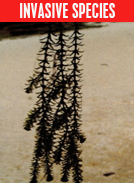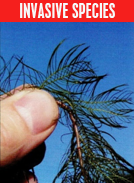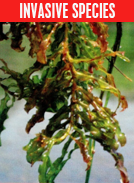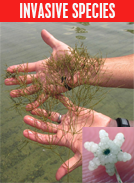Invasive Weeds
If you see them, report them!The most invasive weed species in Indiana are:
 |
 |
 |
 |
Hydrilla
|
Eurasian Watermilfoil
|
Curly-Leaf Pondweed
|
Starry Stonewort
|
Learn to Identify These Weeds
Be watchful at your own pier or as you boat. These weeds, left untreated, can displace the good aquatic plants, interfere with fish species and other aquatic animals and can upset the ecology of the lake.
Report to the Environment Committee
Contact a member of the Environmental Committee to report sightings.
What you Can Do to Control Weeds
Weeds are part of lake ecology. We do not want to remove all weeds from the lake. Weeds also provide habitat for fish and other aquatic species. However, some weeds are harmful to the ecology of the lake and other weeds, left unchecked, clog boating lanes and reduce the sunlight into the depth with can hurt the ecology of the lake.
Don’t Use Phosphorus
- Seaweed uses phosphorus to grow.
- Tell your local supplier or lawn care provider that you only want zero phosphorus fertilizer.
- Once released into the lake it stays in the sediment.
Preserve Our Lake Bottom
- Stirring lake bottom suspends the phosphorus.
- Accelerating in shallow water creates sediment plumes.
- Wakeboard and surf in deeper water (You will have a larger wake anyway).
- Begin pulling skiers and tubers in deep water.
Respect the Ecozone
- The Ecozone acts as a natural water filter only if the lake bottom is undisturbed.
- Only trolling motors are allowed within the ecozone buoys. You can be ticketed if you use a motor within these buoys.
Weed Killer Applications
Some residents fight invasive and nuisance weeds by cooperatively hiring an aquatic weed control company. Great care must be taken to put only appropriate chemicals in the lake. State law limits the area sprayed. Check with the Indiana DNR before you spray. While you might feel like putting Round Up in the lake, please don’t!
Future of Weed Control at Simonton Lake
In 2017 the Simonton Lake Conservancy District added weed control to its purposes. Tax dollars are now used to fund an invasive weed control program. Areas affected are sprayed twice a year.
While this removes the need for individuals to spray weeds near their property, it does not remove the need for all of us to be able to identify and report infestations.